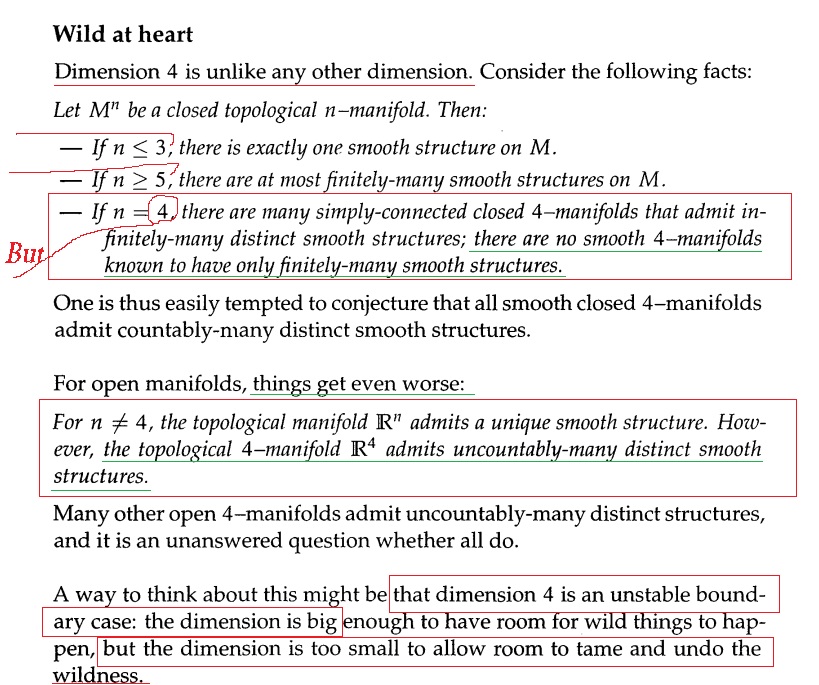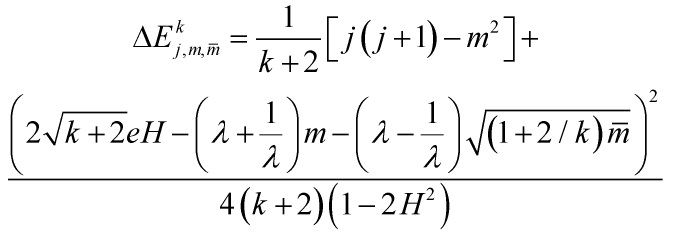I last derived spacetime physics from the string worldsheet, here I shall derive 4-D physics on exotic manifolds in the context of super-string theory. Before proceeding, recall the key steps: since the solution to the Lagrange multiplier equation of motion is
![]()
with its Clifford form
![]()
for ![]() any scalar. Hence, for
any scalar. Hence, for ![]() , we have:
, we have:
![Rendered by QuickLaTeX.com \[\frac{{\not D_\mu ^{susy}L}}{{{{\not \partial }_{{v_a}}}}} - {\mkern 1mu} \frac{\partial }{{{{\not \partial }_{{\sigma _b}}}}}\left( {\frac{{\not D_\nu ^{susy}L}}{{\not \partial \left( {{{\not \partial }_{b,{v_a}}}} \right)}}} \right) = 0 = {g^{ab}}\left[ {{G_{25,25,{v_a}}} + {G_{25,\mu }}{X^\mu }} \right] + i{\varepsilon ^{ab}}\left[ {{B_{25,\mu }}\not \partial {X^\mu } + {{\not \partial }_b}{X^{25}}} \right]\]](https://www.georgeshiber.com/wp-content/ql-cache/quicklatex.com-e8dd897e5d8e3e36f5e6e5843469fcc9_l3.png)
Now, by solving via a ![]() metric:
metric:
![]()
we get the Dp action:
![Rendered by QuickLaTeX.com \[S_p^D = \, - {T_p}\int\limits_{{\rm{worldvolumes}}} {{d^{p + 1}}} \xi \frac{{\not D_{\mu \nu }^{susy}L}}{{{{\not \partial }_{{v_a}}}}}{e^{ - {\Phi _{bos}}}}{\rm{de}}{{\rm{t}}^{1/2}}G_{ab}^{\exp \left( {H_{p + 1}^{{\rm{array}}}} \right)}\]](https://www.georgeshiber.com/wp-content/ql-cache/quicklatex.com-3ee868f0f83c3f66855aa2539b9a4822_l3.png)
And since in 4-dimensional space-time, the mass of a Dp-brane can be derived as:
![Rendered by QuickLaTeX.com \[{T_p}{e^{ - {\Phi _{bos}}}}\prod\limits_{i = 1}^p {\left( {2\pi nR} \right)} \]](https://www.georgeshiber.com/wp-content/ql-cache/quicklatex.com-3c2f43a024963feed958e11d0d7d3fbf_l3.png)
by T-dualizing in the
![]()
direction and factoring the dilaton, the dual is hence:
![Rendered by QuickLaTeX.com \[\begin{array}{c}({T_p}\left( {2\pi \sqrt {\alpha '} } \right){e^{ - {\Phi _{bos}}}}\prod\limits_{i = 1}^{p - 1} {\left( {2\pi {R_p}} \right)} = \\{T_{p - 1}}{e^{ - \Phi _{bos}^{1/2}}}\prod\limits_{i = 1}^{p - 1} {\left( {2\pi {R_{p - 1}}} \right)} \end{array}\]](https://www.georgeshiber.com/wp-content/ql-cache/quicklatex.com-8810308c79381bf0f22ba417dce0c20b_l3.png)
By matrix world-volume integral reduction on
![Rendered by QuickLaTeX.com \[S_p^D = \, - {T_p}\int\limits_{{\rm{worldvolumes}}} {{d^{p + 1}}} \xi \frac{{\not D_{\mu \nu }^{susy}L}}{{{{\not \partial }_{{v_a}}}}}{e^{ - {\Phi _{bos}}}}{\rm{de}}{{\rm{t}}^{1/2}}G_{ab}^{\exp \left( {H_{p + 1}^{{\rm{array}}}} \right)}\]](https://www.georgeshiber.com/wp-content/ql-cache/quicklatex.com-3ee868f0f83c3f66855aa2539b9a4822_l3.png)
the Polyakov action for the string is given as:
![]()
with ![]() the embedding of the string in target space,
the embedding of the string in target space, ![]() the worldsheet metric, and
the worldsheet metric, and ![]() the spacetime metric. The renormalization Lie-equation for the sigma-model on the string worldsheet entails that
the spacetime metric. The renormalization Lie-equation for the sigma-model on the string worldsheet entails that
![]()
So, from
![Rendered by QuickLaTeX.com \[\begin{array}{c}({T_p}\left( {2\pi \sqrt {\alpha '} } \right){e^{ - {\Phi _{bos}}}}\prod\limits_{i = 1}^{p - 1} {\left( {2\pi {R_p}} \right)} = \\{T_{p - 1}}{e^{ - \Phi _{bos}^{1/2}}}\prod\limits_{i = 1}^{p - 1} {\left( {2\pi {R_{p - 1}}} \right)} \end{array}\]](https://www.georgeshiber.com/wp-content/ql-cache/quicklatex.com-8810308c79381bf0f22ba417dce0c20b_l3.png)
the Einstein vacuum field equation is hence encoded in the quantum structure of the conformal worldsheet theory as characterized by
![]()
Therefore, the β-function equation gives a definition of the stress-energy tensor for the worldsheet theory
![]()
with
![]()
By holographic renormalization, it follows that the worldsheet quantum theory knows all about spacetime physics
as attested by
![Rendered by QuickLaTeX.com \[\frac{d}{{{d_{{\sigma _p}}}}}\int\limits_{{\rm{worldvolumes}}}^p {{e^{H_{p + 1}^{{\rm{array}}}}}} + \underbrace {\sum\limits_{{\sigma _p}}^D {{{\left( {S_p^D} \right)}^{ - H_{p + 1}^{{\rm{array}}}}}} }_{{\rm{topologies}}}\]](https://www.georgeshiber.com/wp-content/ql-cache/quicklatex.com-eac6615751f3de7e728719e91821ec83_l3.png)
The key to this post is the avoidance of the standard methods of deriving 4-D physics via compactification, flux stabilization, Dp-brane-theory or first-order AdS/CFT correspondence/holography and will attempt a purely geometric method based on exotic smooth 4-D topological manifolds.
To appreciate the uniqueness of 4-D manifolds, and why M-theory is essential for 4-D physics, absorb the following facts, from Alexandru Scorpan
and so, “there goes the neighborhood”:
This is where the magic of superstring theory comes in. When formulated on backgrounds containing 4-dimensional exotic ![]() rather than standard
rather than standard ![]() , topological surgical tensor-network methods allow 4-D exotic
, topological surgical tensor-network methods allow 4-D exotic ![]() to orbifoldize with worldsheets of strings. So we re-capture the fact that in string theory, the notion of space-time as a smooth manifold is no longer valid due to vacuum fluctuations of the worldsheet, which is ‘complex’, where 4-D physics emerges as a classical-limit with a geometry (M, g, B), and such exotic
to orbifoldize with worldsheets of strings. So we re-capture the fact that in string theory, the notion of space-time as a smooth manifold is no longer valid due to vacuum fluctuations of the worldsheet, which is ‘complex’, where 4-D physics emerges as a classical-limit with a geometry (M, g, B), and such exotic ![]() relative to the background, are classified by the integral classes of
relative to the background, are classified by the integral classes of ![]() -geometric objects representing the third cohomologies of the associated complex line bundles: hence the existence of Abelian gerbes, and the presence of B-field such that H is the curvature of such a gerbe means that the correct, semi-classical, geometry for string theory is the one based on Abelian gerbes supplementing Riemannian geometry and the dilaton is constant and
-geometric objects representing the third cohomologies of the associated complex line bundles: hence the existence of Abelian gerbes, and the presence of B-field such that H is the curvature of such a gerbe means that the correct, semi-classical, geometry for string theory is the one based on Abelian gerbes supplementing Riemannian geometry and the dilaton is constant and ![]() vanishes, and the β-function forces the background be non-flat unless
vanishes, and the β-function forces the background be non-flat unless ![]() is zero.
is zero.
Here’s a deep theorem proven by Torsten Asselmeyer-Maluga and Jerzy Król:
For any family of exotic ![]() ‘s in the radial family whose members are embedded in standard
‘s in the radial family whose members are embedded in standard ![]() , there exists an associated family of 3-spheres in the boundaries of the Akbulut-corks for these exotic
, there exists an associated family of 3-spheres in the boundaries of the Akbulut-corks for these exotic ![]() ’s and each such exotic 4-fold from that family is determined by the codimension-1 foliation of the corresponding 3-sphere, with non-vanishing Godbillon–Vey class in
’s and each such exotic 4-fold from that family is determined by the codimension-1 foliation of the corresponding 3-sphere, with non-vanishing Godbillon–Vey class in ![]() . The radius in the family,
. The radius in the family, ![]() , and value of
, and value of ![]() being related as
being related as ![]() . Yet, the classification of D-branes in string backgrounds is characterized by K-theory of the background.
. Yet, the classification of D-branes in string backgrounds is characterized by K-theory of the background.
Here is where M-theory comes in. Without loss of generality, we can take the bosonic ![]() -WZW model. Now, as
-WZW model. Now, as ![]() , D-branes in
, D-branes in ![]() G-manifolds are determined by wrapping the conjugacy classes of
G-manifolds are determined by wrapping the conjugacy classes of ![]() , and so there are k + 1 D-branes on the level k
, and so there are k + 1 D-branes on the level k ![]() WZW model. Non-commutative gauge theory emerges on the tangent bundle of the monster group-manifold. Now, let
WZW model. Non-commutative gauge theory emerges on the tangent bundle of the monster group-manifold. Now, let ![]() be the representation of
be the representation of ![]() .
.
So, the non-commutative action for the dynamics of N-branes of type ![]() in the string regime is hence:
in the string regime is hence:
with the curvature form:
![]()
with the non-commutative Chern–Simons action being
![]()
The uniqueness of superstring theory is that the fields  , µ = 1, 2, 3, are defined on a fuzzy 2-sphere
, µ = 1, 2, 3, are defined on a fuzzy 2-sphere 
that is:
![]()
with  the fuzzy spherical string-harmonics and
the fuzzy spherical string-harmonics and  the Chan–Paton matrix-valued coefficients
the Chan–Paton matrix-valued coefficients
Thus, the equations of motion are:
![]()
whose solutions describe the dynamics of the brane, and so there exists a continuous map between the partition functions governed by the Verlinde fusion rules coefficients
![]()
which is
![]()
and the sum of characters
![]()
where
![]()
Therefore, there are k + 1 stable branes wrapping the conjugacy classes indexed by ![]() and so putting N point-like branes at the pole causes their decay to the spherical brane
and so putting N point-like branes at the pole causes their decay to the spherical brane ![]() wrapping the conjugacy class. Adding more point-like branes to the stack at the pole gives the more distant
wrapping the conjugacy class. Adding more point-like branes to the stack at the pole gives the more distant ![]() branes until one reaches the opposite pole.
branes until one reaches the opposite pole.
In the case of ![]() , one gets:
, one gets:
![]()
So, by the above theorem, we can place ![]() at the boundary of the Akbulut-cork for some exotic smooth
at the boundary of the Akbulut-cork for some exotic smooth ![]() from the radial family.
from the radial family.
Deep: it follows that small exotic ![]() ’s generate the group of Ramond-Ramond charges of D-branes in the curved background of
’s generate the group of Ramond-Ramond charges of D-branes in the curved background of
![]()
So we have: the classification of Ramond-Ramond charges of the branes on the background given by the group manifold  at the level k corresponds to the exotic smoothness on
at the level k corresponds to the exotic smoothness on  containing
containing  as the part of the boundary of the Akbulut-cork, and the geometry of the stack of NS5-branes in type II superstring theories correlates with the change of the smoothness structure on the transversal
as the part of the boundary of the Akbulut-cork, and the geometry of the stack of NS5-branes in type II superstring theories correlates with the change of the smoothness structure on the transversal  that induces a Chan–Paton Hilbert space, and so topological quantum Dp-branes are exactly those branes determined by the wild embeddings
that induces a Chan–Paton Hilbert space, and so topological quantum Dp-branes are exactly those branes determined by the wild embeddings  . Hence, 4-D physics arises in the regime of SUGRA backreactions
. Hence, 4-D physics arises in the regime of SUGRA backreactions
as witnessed by:
Thus, exotic  regions in 4-space-time act as magnetic monopoles! And in Riemannian geometry and General Relativity, there is always some large exotic smooth
regions in 4-space-time act as magnetic monopoles! And in Riemannian geometry and General Relativity, there is always some large exotic smooth  that acts as an external source of gravitational fields in 4-D space-time
that acts as an external source of gravitational fields in 4-D space-time







1 Response
String-Theory and the String/Non-Local-'Particles' Duality
Tuesday, July 26, 2016[…] 'non-local-particles' (Pages 51-67) can be symmetrically identified with strings in string-theory. Consider, as I showed, the non-commutative action for the dynamics of N-branes of type J in the string […]